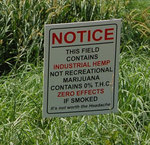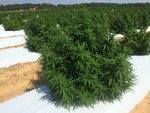




Hemp farming is growing in North Carolina and the potential economic benefits are drawing interest from established farmers and new farmers alike.
After the first year of production, Hemp Industry Daily determined that North Carolina was the eighth largest producer of hemp in the country in 2017. The following year, the state had more than tripled its registered farmers, from 97 to 340. Two hemp workshops held by the Chatham County Center of North Carolina Cooperative Extension were sold out, with more than 250 attendees representing not just counties throughout the state, but five other states in the region.
What is hemp?
Industrial hemp is a variety of cannabis sativa. Marijuana is another variety of the same plant, but the two differ in significant ways.
The major difference is the amount of THC each plant contains. THC is the intoxicating substance in the plant. Marijuana averages around 30 percent THC while hemp contains usually less than .3 percent. Hemp also contains more Cannabidiol or CBD than marijuana, which is a non-intoxicating compound with numerous medicinal qualities.
Various parts of the industrial hemp plant can be used for a diverse array of industries. The hearty stalk and fiber can be used for paper, fabric, bedding, and even construction materials such as energy efficient hempcrete.
The flower can be used for seed for food or can be infused into CBD for products that have been scientifically proven to have positive health effects such as reducing pain, reducing anxiety and depression, and alleviating some cancer-related symptoms.
A majority of hemp grown in North Carolina, above 95 percent, is for CBD production. However, there are many who believe that growing the plant for fiber, especially in North Carolina which has a rich history of textile production, is the next big move for hemp in the state. Hemp-cotton fabrics are stronger than pure cotton fabrics and it uses less water and has a shorter cultivation period than cotton.
Pittsboro's Oak City Hemp helps farmers
Hemp for fiber production
Eric Henry is the owner of TS Designs, a t-shirt company founded in 1977, who is making big efforts to build a manufacturing plant that will convert hemp fiber into hemp thread for fabric production, a first in the U.S. Henry notes that while the federal and state governments have passed legislation legalizing and supporting hemp production, the infrastructure to handle manufacturing the fiber was not in place.
“I think nobody was going to make an investment prior to it being legal at the federal level,” Henry said.
Without domestic manufacturing facilities, hemp fabric is imported, mostly from China, which has a robust hemp manufacturing market. In fact, most of the hemp seeds and clones are also imported from China as the domestic market has not been able to keep up with the pace of growth in the industry.
Arlo Estill, owner of Hempsmith, a hemp fabric clothing line based in Pittsboro, is also hoping to see a hemp manufacturing plant in North Carolina. Estill is importing his hemp fabrics from China and is having the fabric sewn in New York. Those pieces are then sent to Pittsboro where he and his business partner Tristan Nelson do the embroidery, tie-dying, other personalization, the “final value-added” things, as he calls them for the Hempsmith line.
See Hempsmith's Sustainable Fashion Show
“I don’t love the off-shoring,” Estill said, noting the difficulty in contacting all the various entities if he receives product that have holes or irregularities.
Henry’s TS Designs has a line of shirts called “Cotton of the Carolinas,” t-shirts made from conventionally grown North Carolina cotton and processed in the state. The entire process, through the supply chain, can be traced back to the farmer. The point, Henry says, is to have a transparent supply chain where farmers have a seat at the table. Henry believes the same can be done with hemp production.
Estill noted, similarly stating, that “we have a cotton of the Carolinas, I would love to see a hemp of the Carolinas. I want to bring it home. I want to know the farmer, I want to know the sewer.”
He added, “We have the best apparel manufacturing. It would be a boost to those industries and add another whole dimension other than importing from overseas.”
Hemp for fiber is a different variety than those bred for flower or CBD, according to Henry. He has been working with the N.C. State University’s industrial hemp department to secure fiber specific seeds and begin trials on the plant. He believes a manufacturing plant would need 10,000 acres of industrial hemp to justify the construction of the facility. Henry would like to see that all happen in North Carolina.
The fiber hemp plant grows taller and can be grown closer than those for CBD and are harvested before the plant flowers, removing the worry of the plant inadvertently developing a THC level above the legal .3 percent limit. The process uses only the stalks, no branches, leaves, or flowers. The inner layer of the stalk, the hurd, can be used for filtration and other construction applications. The outer layer of the stalk is used for fiber. The stalks would be separated in the fields at harvest.
The manufacturing process starts with the removal of the lignin, a kind of glue that gives the fiber its rigidity. In China, the stalks are soaked in water, however Henry is looking into the use of enzymes to perform the process. Following that, the process is similar to cotton where a gin straightens out the fiber and combs it. Those fibers are then combined with cotton to soften the feel of the fiber, and spun into a fiber to be used to create fabric.
“It looks like big cones of yarn, but you have to weave it, finish it, cut and sew it,” Henry said.
Henry believes were are still a couple of years away from growing and processing hemp for fabric in the U.S., but thinks it is coming. While working with N.C. State University on the growing of fiber hemp, he is also working to find investors for the processing facility. He estimates that a 20,000 square-foot facility would only cost a couple million dollars.
“There’s really not much to it from a processing standpoint,” he said, noting the bigger challenge is trying to solve the supply of hemp from 10,000 acres in the burgeoning industry.
What we’ve learned so far — CBD production
Since the first hemp field was planted in North Carolina in 2016, experts have learned a lot, but there’s a lot more to learn.
Caring for an industrial hemp crop has its own challenges. Because the regulation of hemp farming is new, North Carolina does not allow any farmer who cultivates the flower to use any sprays on the plants for pests or disease as they are unsure of any effect those sprays may have on the quality of the oils the flower produces. The equipment to harvest field hemp is expensive. In addition, as the program in North Carolina is young, a system of manufacturing and marketing is still developing.
The most common form of hemp production is for CBD’s, a process that focuses on quality versus quantity. Blake Butler, Executive Director of the North Carolina Industrial Hemp Association, says that interested farmers should view themselves like heirloom tomato growers. Butler urges growers to start small and scale up, starting with between two and five acres to learn about the crop. However, he notes that both the state and N.C. State University have made it a focus to get it right.
Phil Wilson, director of the N.C. Department of Agriculture’s plant industry division, believes that the program is “ready to move to the next level based on what we’ve done so far.” Specifically, he is urging hemp farmers to seek out NC producers when looking for clones to plant rather than China which has been traditionally the biggest supplier to farmers in the U.S.
Any hemp grown in North Carolina must have THC levels below .3 percent. Hemp fields are visited and tested. If any of the plants register above the allowed amount of THC, the entire crop must be destroyed. Wilson suggests that farmers begin scheduling their required THC crop testing as soon as budding begins. He also suggests separating different varieties so that if one variety tests over the allowed THC levels, only that portion of the crop would need to be destroyed.
Keith Edmisten, Cotton & Industrial Hemp Extension Specialist at N.C. State University, reviewed some of the struggles new hemp farmers encountered, mostly due to inexperience with the plant. For example, there were a lot of root problems due to plants being in pots to long before planting. Other plants encountered disease that caused them to fall over requiring $3,000-4,000 of support systems per acre. Hemp does not like “wet feet,” but needs water. It does require proper fertilization, but notes that it’s best to only use nitrogen in order to prevent THC production. It does have pest problems, but to date, no pesticide has been approved for food grade hemp like those used for CBD production.
Even with these growing pains and challenges, proponents of the hemp industry remain positive on its potential in North Carolina.
“We have the opportunity of a lifetime to finally empower the farmer again,” Butler said. “Everyone [state government, researchers, and farmers wants to meet this gold standard in North Carolina.”
Casey Mann can be reached at CaseyMann@chathamnr.com.
Other items that may interest you
